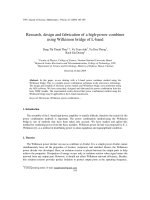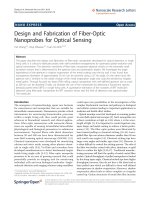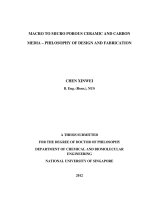Design and fabrication of microneedles for drug delivery
Bạn đang xem bản rút gọn của tài liệu. Xem và tải ngay bản đầy đủ của tài liệu tại đây (5.04 MB, 184 trang )
DESIGN AND FABRICATION OF MICRONEEDLES FOR
DRUG DELIVERY
JI JING
NATIONAL UNIVERSITY OF SINGAPORE
2007
DESIGN AND FABRICATION OF MICRONEEDLES FOR
DRUG DELIVERY
JI JING
( B.Eng.,M.Eng., NWPU, CHINA)
A THESIS SUBMITTED
FOR THE DEGREE OF DOCTOR OF PHILOSOPHY
DEPARTMENT OF MECHANICAL ENGINEERING
NATIONAL UNIVERSITY OF SINGAPORE
2007
Acknowledgements
i
Acknowledgements
I’m very thankful that I have the opportunity to do my graduate study at National University of
Singapore. My four years here have been challenging, but the knowledge and experience which
I learnt at NUS will benefit me in the years to come.
I would like to thank Professor Francis, EH Tay, my advisor, for providing the opportunity to
work on microneedles for the drug delivery project. He was always a source of support during
my graduate. At my first group meeting in Dr. Tay’s group, he encouraged us to be innovative
researchers. I am very interested in the microfabrication technology. Dr. Tay provided fantastic
research opportunities in doing microfabrication. He had always allowed students to explore
their own interests and really make research projects their own.
I would like to thank Professor Miao Jianming, for the helpful discussion and suggestions about
my research and answering my microfabrication processing questions. Dr. Miao was able to
provide process equipment for my work. After meeting with Dr. Miao a few times, I found out
that he can do much more than providing the equipment, he was a true visionary with a deep
understanding about the microfabrication technology.
Acknowledgements
ii
I would like to thank Professor Yung C. Liang and Professor Yoo Won Jong, for participating
in my Qualifying Examination, as well as being thesis committee members.
I would like to thank all the members of the MEMS lab and MNSI, ZhaoYi, Wei Jiashen, Li Jun,
Gao Chunping,Yu Liming, Shi Yu, and Nyan Myo Naing, for their suggestions and sharing of
experience over the years.
I would like to thank the medical device group in IBN, for providing an opportunity to learn
microfabrication technology.
I would like to thank NTU Micromachining Center staff, for their kindness to help me with
setting up new experiments or working with new equipment.
I would like to thank my friends in Singapore, China, and Unite States, for encouraging me
when I was frustrated. Especially, for my best friend, Zhu Xia, we always forgot the time when
we were on the phone. I appreciate the friendships she has provided.
Most important of all, I would like to thank Xun Guo, my husband, for the innumerable
sacrifices he has made to walk this journey with me. His unwavering support during my
Acknowledgements
iii
graduate study and his suggestions on my research made those tough days much easier. He is
always staying there for me and watching over me.
I also would like to thank my parents and the rest of my family, for their understanding and
continual support. I would like to thank my mum and dad for their unlimited love.
Ji Jing
January 2007
Table of Contents
iv
Table of Contents
Pages
ACKNOWLEDGEMENTS I
TABLE OF CONTENTS IV
SUMMARY VIII
LIST OF TABLES X
LIST OF FIGURES XI
LIST OF SYMBOLS XVI
CHAPTER 1 INTRODUCTION 1
1.1 Overview of Microneedle Applications 1
1.1.1 Motivation of Research on Microneedle 2
1.1.2 Specific Applications of Microneedle in Drug and Gene Delivery 4
1.2 Overview of Microfabrication Technology 7
1.3 Thesis Objectives 8
CHAPTER 2 REVIEW OF MICROFABRICATED
MICRONEEDLES 12
Table of Contents
v
2.1 Microneedles in Transdermal Drug Delivery 12
2.1.1 Microfabrication Technology 14
2.1.2 Drugs Loading Methods 20
2.1.3 Insertion Mechanism 21
2.2 Microneedles in Local Delivery 22
2.2.1 Microfabrication Technology 23
2.2.2 Fluid Analysis 30
2.2.3 Structure Fracture Analysis 31
2.3 Discussion 32
CHAPTER 3 MICRONEEDLE ARRAY WITH
BIODEGRADABLE TIPS FOR TRANSDERMAL DELIVERY 35
3.1 Design of Microneedle Array with Porous Tips 35
3.2 Experimental Methods 40
3.2.1 Isotropic Etching in Inductively Coupled Plasma (ICP) 43
3.2.1.1 Pressure 50
3.2.1.2 Vertical etching depth (V) 52
3.2.1.3 Lateral etching length (L) 53
3.2.1.4 Ratio of vertical etching to lateral etching (V/L ratio) 55
3.2.1.5 Photoresist etching rate 57
3.2.2 Photoresist Reflow Process 58
3.2.3 Anodic Electrochemical Etching 59
3.3 Experimental Results 62
3.3.1 Isotropic Etched Microneedle Structure 62
3.3.2 Anodic Electrochemical Etched Structure 66
3.4 Discussion 71
3.4.1 Fabrication of Microneedle Structure 71
3.4.2 Porous Silicon Formation 73
CHAPTER 4 ANALYTICAL MODEL AND INSERTION TEST OF
THE MICRONEEDLE ARRAY 75
Table of Contents
vi
4.1 Theory of Microneedle Insertion into Skin 76
4.2 Analytical Model of Fracture Forces 79
4.2.1 Analysis of Bending Force 81
4.2.2 Analysis of Buckling Force 85
4.3 Testing of Fabricated Microneedles 88
4.4 Discussion 94
CHAPTER 5 DESIGN AND FABRICATION OF MICROSYSTEM
FOR INJECTION 96
5.1 Design Specification 96
5.1.1 Design of Flow 99
5.1.2 Design of Actuation Mechanism 107
5.2 Experimental Methods 115
5.2.1 Microfabrication Process of Hollow Microneedle Array 115
5.2.2 Microfabrication Process of Glass 118
5.2.3 Combination Process of Isotropic Etching and Deep Etching 119
5.2.4 Glass Deep Wet Etching 121
5.3 Experimental Results 124
5.3.1 Fabricated Hollow Microneedle Array 124
5.3.2 Glass Deep Wet Etch Results 126
5.4 Discussion 133
5.4.1 Microneedle Based Microsystem 133
5.4.2 Structure Improvement of the Hollow Microneedle 134
CHAPTER 6 CONCLUSIONS AND FUTURE WORK 139
6.1 Summary of Results 139
6.2 Major Contributions 141
6.3 Suggestions for Future Work 143
Table of Contents
vii
BIBLIOGRAPHY 147
APPENDIX A. PUBLICATIONS RELATED TO THIS THESIS 163
Summary
viii
Summary
Microneedle array with biodegradable porous tips was designed and fabricated for the
application of transdermal drug delivery. Pyramidal silicon microneedles with sharp tips were
fabricated by an isotropic etching process in an inductively coupled plasma (ICP) etcher. Using
full factorial factors design method, each effect of the process variables on etching results was
analyzed to optimize the isotropic etching process. The results of the design of experiment
(DOE) model indicate that the etching rates are predominantly depended on the ion flux which
is related with coil power and SF
6
flow rate. The higher V/L ratio benefits from lower SF
6
flow
rate and higher platen power. The photoresist etching rate increases with platen power
increasing. Moreover, the process of photoresist reflow was developed to expose top part of tips
which were deposited by a silicon nitride layer. In addition, the biodegradable porous tips were
then fabricated by an optimized anodic electrochemical etching process. The electrochemical
etching conditions were characterized to investigate the formation of porous silicon with
various porosities and structures. It was found that macroporous structure was formed in
HF/acetone nitride (MeCN) electrolyte while the nanoporous structure was observed using
HF/ethanol solution. The higher porosity was obtained at higher current density and longer
etching time.
Summary
ix
An analytical model was built up to predict the critical loadings of a microneedle during
insertion. For a single porous tip needle with 30 µm height, a 5 µm length of top side, and a 20
µm length of bottom side, the critical buckling force is found to be 39 mN which is much
greater than the force (~3.25 mN) required for insertion into the skin. The critical bending force
for the needle is found to be 0.6 mN, which is also greater than the bending force (~0.24 mN)
exerted during insertion. The variation in width dimensions that would lead to borderline (1.3 N)
capacity was characterized to determine the values of width dimensions. Microneedle insertion
experiments were carried out to investigate the insertion ability of the fabricated microneedle
arrays. The results of insertion test verify that the fabricated microneedle array with porous tips
is able to create microholes on the skin.
A microsystem consisting of a hollow silicon microneedle array and glass pump components
was further designed and fabricated for injection. Dimensions for the inner channel and
actuator mechanism were designed to deliver a desired flow rate. In the design, a 10 by 10
microneedle array with inner diameters ranged from 14 µm to 16 µm could deliver water at 100
µL in 60 seconds. The high aspect ratio, hollow microneedle array was fabricated using a
dual-step dry etching process which includes deep reactive ion etching (DRIE) and isotropic
etching. In addition, an optimized HF/HCL solution was developed to fabricate the glass
components. Atomic force microscope (AFM) images of the etched glasses verified that the
quality of surface was improved by using the solution, HF/HCl with the ratio 10:1 in volume.
List of Tables
x
List of Tables
Pages
Table 3.1 Range of explored variables for isotropic etching 47
Table 3.2 The experimental design for isotropic etching in ICP 49
Table 5.1 Design of the actuator 112
Table 5.2 Properties of common PZT [96] 113
Table 5.3 Composition of Pyrex Corning 7740 and Soda lime 123
Table 5.4 Resistant time of masking layers in two etchants 133
List of Figures
xi
List of Figures
Pages
Figure 1.1 Schematic of designed microneedle array with biodegradable tips 10
Figure 1.2 Schematic of microsystem based on hollow microneedle array 11
Figure 2.1 Schematic representation of a cross section through human skin [29] 13
Figure 2.2 Micrographs of fabricated microneedles including microfabrication
processes, for transdermal drug delivery 15
Figure 2.3 Micrographs of fabricated microneedles including microfabrication
processes, in local delivery 24
Figure 3.1 Microneedles in transdermal drug delivery 35
Figure 3.2 SEM picture of damaged microneedle tip after insertion 36
Figure 3.3 Schematic of microneedle array with porous tips 40
Figure 3.4 Schematic of the fabrication process used in making the needles with
porous tips 42
Figure 3.5 Isotropic profile formed in ICP etching cycles 44
Figure 3.6 SEM picture of etched slope 44
Figure 3.7 Cross-section of ICP etch tool 46
Figure 3.8 The dimension used in microneedle fabrication 48
Figure 3.9 Normal probability plot of effects on pressure 51
Figure 3.10 Pressure (mTorr) dependence on SF
6
flow rate (sccm) and APV
position in degree 51
Figure 3.11 Normal probability plot of effects on vertical etching depth 53
Figure 3.12 Vertical etching depth (µm) dependence on SF
6
flow rate (sccm) and
coil power (W) 53
Figure 3.13 Normal probability plot of effects on lateral etching length 54
List of Figures
xii
Figure 3.14 Lateral etching length (µm) dependence on SF
6
flow rate (sccm) and
coil power (W) 55
Figure 3.15 Normal probability plot of effects on V/L ratio 56
Figure 3.16 V/L ratio dependence on SF
6
flow rate (sccm) and platen power
(W) 56
Figure 3.17 Normal probability plot of effects on photoresist etching rate 57
Figure 3.18 SEM Picture of microneedles coved by photoresist (top view) 59
Figure 3.19 Schematic of the equipment set up for porous silicon formation 61
Figure 3.20 SEM pictures of fabricated microneedle in SF
6
gas and SF
6
/O
2
gas 63
Figure 3.21 SEM photography of profile variation f at different pressures 64
Figure 3.22 SEM photos of the needle arrays fabricated by DRIE ICP of STS at
the controlled parameters 65
Figure 3.23 SEM pictures of microneedle with lower surface roughness 66
Figure 3.24 SEM pictures of porous silicon surface achieved in electrolyte using
HF/EtOH at different current densities ((a) 10mA/cm
2
(b)
20mA/cm
2
) 67
Figure 3.25 SEM pictures of porous silicon surface achieved in electrolyte
using HF/MeCN at different current densities ((a) 5mA/cm
2
(b)
10mA/cm
2
) 67
Figure 3.26 SEM photos of porous tips, etched in HF/MeCN, at 4mA/cm
2
,
10min 68
Figure 3.27 SEM photos of porous tips, etched in HF/MeCN, at 10mA/cm
2
,
30min 69
Figure 3.28 SEM photos of porous tips, etched in HF/MeCN, at 10mA/cm
2
,
50min 70
List of Figures
xiii
Figure 3.29 SEM pictures of microneedles fabricated in KOH with mask
patterned in squares. 72
Figure 3.30 SEM pictures of microneedles fabricated in KOH using modified
mask with round corner 73
Figure 4.1 Modelling for microneedle 80
Figure 4.2 Model for the analytic solution of critical loadings: (a) bending and
buckling model of microneedle, (b) schematic diagram of the square
pyramid column 81
Figure 4.3 The critical bending forces and the insert limitation as a function of
the top length for five different base length cases 85
Figure 4.4 The critical buckling forces and the insert limitation as a function of
the top length for five different base length cases 88
Figure 4.5 Schematic drawing of insertion set up for microneedles 89
Figure 4.6 SEM pictures of solid microneedle array before insertion 89
Figure 4.7 SEM pictures of solid microneedle array after insertion 90
Figure 4.8 SEM pictures of microneedle array before and after insertion 91
Figure 4.9 Photomicrograph of sample skin after microneedles were inserted
and removed 91
Figure 4.10 SEM pictures of microneedle array after insertion 92
Figure 4.11 Picture of sample skin after piercing with microneedles 93
Figure 4.12 Photomicrograph of sample skin after microneedles were inserted
and removed 94
Figure 5.1 Schematic drawing of a microchip for drug injection 97
Figure 5.2 Schematic channel cross section of the microneedle 99
Figure 5.3 Estimation of inner channel diameter of the microneedle with the
variation of pressure drop at different flow rates 103
List of Figures
xiv
Figure 5.4 Saturated values of pressure drop for different flow rates 104
Figure 5.5 Variation of diameters at various pressure drops for the desired flow
rate 106
Figure 5.6 Estimation of inner channel diameter with the variation of flow rate
at pressure drop at 5 KPa 107
Figure 5.7 Schematic drawing of the channel geometry 108
Figure 5.8 Schematic of cycle of PZT actuation 109
Figure 5.9 Schematic drawing of PZT and glass membrane deflection 110
Figure 5.10 Schematic drawing of membrane deflection 111
Figure 5.11 Estimated membrane deflection and flow rate per stroke 113
Figure 5.12 Actuated frequencies vs. applied voltages during the variation of
flow rate 114
Figure 5.13 A schematic draw of fabrication process used in making the hollow
microneedle array 117
Figure 5.14 A schematic draw of fabrication process used in etching Pyrex glass 119
Figure 5.15 SEM micrograph of microneedle array fabricated in combined
process 121
Figure 5.16 SEM photos of a microneedle array: (a) a hollow microneedle array
(b) plane view of microneedle array (c) side view of microneedle
array (d) backside view of chamber 125
Figure 5.17 Roughness (Ra) variations in the four types of etchant 127
Figure 5.18 Variation of etching rates in four etchants 128
Figure 5.19 Variation of roughness with time 129
Figure 5.20 AFM images of generated surface of Corning 7740 ((a) etched in
concentrated HF and (b) etched in the solution of HF: HCl with
ratio10:1) 130
List of Figures
xv
Figure 5.21 AFM images of generated surface of Soda Lime ((a) etched in
concentrated HF and (b) etched in the solution of HF: HCl with
ratio10:1) 132
Figure 5.22 SEM photo of fracture needle after insertion (an intact needle at left
and chip off needle at right left the etched inner hole. Fracture
occurs at the bottom of the needle.) 135
Figure 5.23 Sketch of the microneedle design with strength enhancement
component 135
Figure 5.24 Fabrication process for microneedles with curved structure 136
Figure 5.25 The schematic mask pattern for microneedles fabrication. (t
1
<t
2
<t
3
) 137
Figure 5.26 SEM pictures of fabricated microneedles with strength
enhancement design ((a) after DRIE, (b) after removal of oxidation) 138
List of Symbols
xvi
List of Symbols
a length of top side of a pyramidal structure, µm
A interfacial surface area, µm
2
b length of bottom side of a pyramidal structure, µm
c perpendicular distance from the neutral axis to the point farthest away from
the neutral axis
d
31
piezoelectric constant
D diameter of the microneedle
D
G
the diameter of glass member
D
PZT
the diameter of PZT disc
f frequency
F force applied by the needle
F
z
the body force
E Young’s modulus of the material
G roughness of skin
G
c
crack fracture toughness of skin
G
p
puncture fracture roughness
H length of the cross-section of a pyramidal structure
I moment of inertia
List of Symbols
xvii
L length of needle
L
d
the length of diffuser
M the bending moment
P loading force
P
cr
buckling force
P
t
bending force
p pressure
p
1
the actuation pressure
p
2
the output pressure
Q volumetric flow rate
S section modulus, which is represented by I/c
t
PZT
the thickness of PZT disc
t
G
glass Membrane thickness, mm
W the work of fracture of the material
W
1
the neck width for inlet
W
2
the neck width for outlet
V
x,
the velocity of the fluid in x direction
V
y
the velocity of the fluid in y direction
V
z
the velocity of the fluid z direction
x the axial position of the needle,
List of Symbols
xviii
x
i
the displacement during insertion,
y the deflected shape of needle
∆p the pressure drop ∆p= p
1
-p
2
V∆
the volume flow per stroke,
∆Z is the deflection in a stroke
Greek Symbols
α
the tapering angle is
1
tan (( ) / 2 )ba L
−
−
γ the divergence angle
θ the pre-exponential constant
µ the viscosity
τ the exponential constant
ρ the density
ε
τ
relative Permittivity
Chapter 1 Introduction
1
Chapter 1 Introduction
1.1 Overview of Microneedle Applications
Microneedles have emerged as important biomedical devices because they have immense
potential applications in different areas of medicine and biology. Microneedles reduce both
insertion pain and tissue damage in a patient due to their small size. The efficiency of
transdermal drug delivery will be increased due to the increased skin permeability when the
skin barrier is pieced mechanically by microneedles [1]. Furthermore, microneedles allow the
implementation of time varying delivery of different therapeutics, which is essential for a more
effective drug delivery system. The direct delivery of DNA/portent based drugs into the
metabolic system and the continuous delivery of insulin to a diabetic patient have been reported
using microneedles [2]. Side-effects of overdose in drug delivery can be minimized by using
the microneedle based microsystems due to their potential ability to release drugs in precise
controlled dosage. Microneedles may also be used to extract and analyze bodily fluids such that
a patient’s metabolite can be continuous monitored [3][4]. Other applications of microneedle
technology include sample collection for biological analysis, delivery of cell or cellular extract
based vaccines, and sample handling. Essentially, microneedles are able to provide the
interconnection between the microscopic and macroscopic world [5].
Chapter 1 Introduction
2
1.1.1 Motivation of Research on Microneedle
During a needle insertion, the damage to the tissue and the likelihood of infection occurring at
the site of insertion are directly related to the size of the needle. Currently, needles used in
common medical applications range from 7 gauge (the largest) to 33 gauge (the smallest) on the
Stubs scale. Twenty-one gauge needles, which have a 813 µm (0.032 inch) outside diameter and
a 495 µm (0.0195 inch) inside diameter, are most commonly used for drawing blood. The
smallest 33 gauge needles have a 203 µm (0.008 inch) outside diameter and a 89 µm (0.0035
inch) inside diameter. Hypodermic needles are normally made from a stainless steel tube which
is drawn through progressively smaller dies. However, it is not feasible to fabricate needles
with a diameter less than 200 µm using this method. In a bid to fabricate microneedle with
dementions less than 100 µm, micrfabrication technologies such as lithography and thin film
deposition have been applied so as to minimalize the invasion effects and reduce the likelihood
of infection.
In the transdermal drug delivery systems, microneedles have the significant advantage over
other transdermal delivery approaches which include chemical enhancer, electroporation,
iontophoresis, sonophoresis, magnetophoresis and thermal energy of increasing permeability of
the skin [6].The microneedles mechanically create the pathway through the upper skin layer
and pierce the upper epidermis so as to increase skin permeability and, therefore, improve drug
delivery efficiency. With microholes in the skin, the drug delivery relied mainly on the
Chapter 1 Introduction
3
subsequent drug absorption into the bloodstream rather than the drug composition and
concentration. The absorption of fluid through the microholes occurs at a much faster rate than
permeation of the same fluid across the skin. Microneedles could provide a promised potential
to deliver the sophisticated drugs, which are not feasible to be delivered in traditional methods
due to the poor absorption and enzymatic degradation in the gastrointestinal tract or liver, to the
blood stream.
In the delivery of drug to local tissues, microneedles were used to transport drugs in less
administered dose to certain target location in order to avoid side effects encountered in the
systemic delivery. Microsystems which consist of microneedles, sensors, micropumps, valves
and flow channel are designed to deliver precise doses of drugs in the tissues. Such concepts
were formulated in recent research [7]. The microsystem will allow a lower drug dosage to be
injected over a longer period of time. This technique helps to maintain a constant drug
concentration in the blood and hence, avoid the side effects associated with a high
concentration bolus injection. Therefore, the microsystem has great potential for the controlled
precise delivery.
Microneedle may also be used to sample body fluids for analysis. The miniaturization of fluidic
devices enables portable devices to be designed for continuous metabolite monitoring of a
person. The portable devices can be used to monitor the glucose level for a diabetes patient. The
Chapter 1 Introduction
4
sampling devices may also be used in cellular operation such as delivery RNA/DNA to
cells/embryo [8].
1.1.2 Specific Applications of Microneedle in Drug and Gene Delivery
Microneedles, which have the capability of piercing skin or other tissues, can be used to deliver
drugs through the skin, into a blood vessel, or into a cell [9]. With the advanced
microfabrication technologies, microneedles which are fabricated using several materials such
as silicon, glass, metal, and polymer have been developed. The microneedles have been
fabricated in-plane, where the needle is parallel to the substrate, or out-of-plane, where the
needle structure is perpendicular to the substrate. Many of fabricated microneedles are designed
for transdermal therapies to deliver drugs such as insulin and heparin. On the other hand,
microneedles can also be used for local delivery of other drugs, for example, drugs in
anti-restenosis and anti-tumor therapies.
In transdermal drug delivery, microneedles are designed to painlessly deliver drugs into
subcutaneous tissue with the rate at therapy level by enhancing skin permeability. The
microneedles have the ability to transport sophisticated drugs to epidermis layer with
significant therapeutic effects [10]. The earliest silicon microneedle array, fabricated by a
reactive ion etching (RIE) process, could increase the skin permeability by up to four orders of
magnitude using a fluorescent dye, calcein [11]. A hollow metal tube array and a hollow metal
Chapter 1 Introduction
5
microneedle array were subsequently demonstrated for transdermal delivery application [12].
These metal microneedles were fabricated by forming polymer or silicon molds and
electrodepositing nickel, gold or other metals onto the molds. These hollow microneedles were
inserted into human epidermis and were shown to increase skin permeability by up to five
orders of magnitude above the assay sensitivity limit. More recently, Park et al developed
biodegradable polymer microneedle array using PDMS mold for replication of the
microneedles [13]. This polymer microneedle array had the ability to increase skin permeability
by up to three orders of magnitude in in vitro experiments; and the microneedle using
biodegradable polymer was show to be clinically applicable. In the above studies, the increase
in skin permeability was observed in both skin test methods: with microneedles (inserted and
left in skin) and without microneedles (inserted and removed from skin). Applications of
microneedles which were fabricated from metal sheets for in vivo transdermal delivery of drugs
such as insulin, oligodeoxynucleotide (ODN) and protein vaccine have been reported. Martanto
et al fabricated the solid metal microneedle array by laser-cutting the shape of each needle out
of a stainless steel sheet [14]. During medical trial test, an insulin solution was placed on top of
the microneedle array which was then inserted into skin for four hours. A significant effect on
blood glucose levels was observed. In another study, other types of metal microneedle arrays
were etched from titanium sheets or stainless steel sheets. Drugs were subsequently coated on
the surface to enhance the effect of in vivo transdermal delivery. Using these microneedle arrays,
Lin et al demonstrated that the ODN delivery flux reached 8.08+0.06 µg/cm
2
/h; and high ODN









